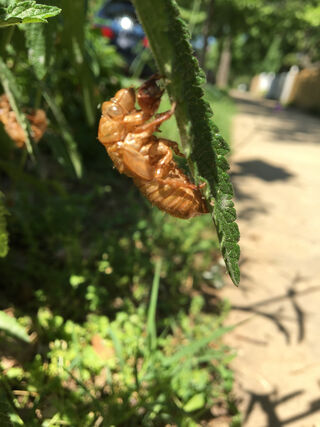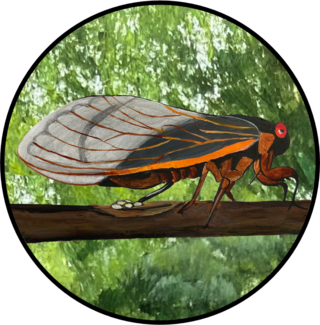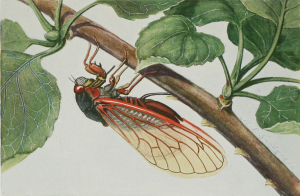Fear
The Brood X Cicadas: Invasion or Blessing?
Change your perspective to a sense of wonder.
Posted May 17, 2021 Reviewed by Lybi Ma
Key points
- Cicadas are not invasive like grasshopper locusts; they are totally harmless to plants, animals, and people.
- They benefit animals, fungi such as mushrooms, and microbes. Forest growth is boosted in the years following an emergence.
- They don't go dormant nor do they hibernate, but feed quietly for the 17 years we don't see them.

After 17 years spent underground feeding out of sight on the juice of tree roots, Brood X, among the largest of the periodical cicadas, is emerging. Numbering in the billions with a density of more than 1 million per hectare (2.5 acres) these insects will blanket forests and leafy neighborhoods across the Eastern half of North America as they mate, lay their eggs, and die. It is a once–in–a–generation chance to behold an unmatched spectacle of nature.
Even as these magnificent creatures start to surface and sing their hypnotic song, misinformation about them abounds. I suppose the yuck factor clings to insects of any sort. But perhaps I can change your perspective and get you to stop thinking of them as ugly or dangerous pests.
They are far from ugly. Once you understand the ecological role that cicadas play, you can greet their emergence with a sense of wonder rather than fear. To help you do so, entomologists at George Washington and Georgetown Universities have created friendtocicadas.org to engage the public in the beauty of the natural world and get kids of all ages excited about science. “We kindly ask that the media use this emergence as an opportunity to educate and excite rather than incite fear and revulsion.”
An educational booklet for third–to–seventh graders uses the insects’ synchronous, massive emergence to develop student skills in history, math, and even creative writing (think haiku contests).
The first misconception about cicadas is that they are invasive. They are not. Documents confirm that 17-year periodical broods have been emerging like clockwork and living among us for centuries, whereas the fossil record shows that they have been with us for at least 4 million years.
Perhaps the synchronous emergence of insect hordes led early settlers to confuse them with earlier-known migratory locusts that appear suddenly in enormous numbers and devastate acre upon acre of crops. One scene in the film Days of Heaven illustrates their lightning-fast destructive power.

Cicadas neither feed on crops nor do they migrate. True locusts are a voracious variety of migrating grasshopper that has fearsome chewing jaws, whereas the Latin name cicada means “tree cricket,” an insect to which they are more closely aligned. They have no stringer and they cannot bite. Their mouths are designed to suck sap, not chew vegetation. They are totally harmless to plants, people, and animals. Dogs, cats, and birds eat them readily without harm—at least until they are stuffed and satiated. Fat, distended Robins are an amusing and common sight during peak emergence.
Squirrels, chipmunks, mice, raccoons, foxes, and even fish feed on them, too. The synchronous emergence of millions of adults over a mere few weeks satiates natural predators, ensuring that enough survive to produce the next generation. At the same time, their enormous number alters the diets of insect-eating birds and mammals. Some species will forage less on their typical prey such as the caterpillars and flies that would otherwise feed on plants and damage them.
As part of the food chain, cicadas have a marked positive effect on populations of animals and plants. Animals get nutrition while plants, fungi, and microbes absorb nutrients from the former’s decaying bodies when they die.
The U.S. has thousands of native herbivore insect species. Periodical cicadas are strict herbivores, meaning that juvenile forms feed only on plants. They don’t harm the host vegetation. In fact, females that lay their eggs in a branch’s outermost twigs act as a pruning mechanism that stimulates new development. Researchers have found increased tree growth in the year following a cicada emergence.

Another misconception is that cicadas go dormant and hibernate during their 17-year absence. Hardly. The juvenile nymphs now emerging have lived alone, each in its own underground chamber eight to twelve inches below the host trees on which they have been feeding since 2004. Only when the soil temperature reaches 64 ℉ (18 °C) do the nymphs dig upwards. They emerge mostly at night when they can molt into their final adult form under the safe cover of darkness.
Many people loathe the unceasing sound cicadas make. They curse it as “a racket” and a nuisance. Yet others like myself are enchanted by the steady thrum the hordes make. The deep repetitive throb sounds like a flying saucer or the soundtrack of a sci-fi movie. During my morning walks the sound swathes and soothes me in a pleasant sensation. Whether one loves or hates cicadas is a matter of perspective; happily, anyone can learn to alter theirs.
Male cicadas sing by vibrating organs on their abdomens called tymbals. This attracts females, who signal back if they like a male’s singing. When Cicadas congregate in a tree canopy in what is called a “chorus,” the sound can be deafening. Male cicadas make about the loudest noise of any insect, reaching 100 decibels—as loud as a jet plane.
Periodical cicadas are also among the longest-living insects on record, 17 years being an exceptionally long lifespan. Once emerged, they survive only three to four weeks, just long enough to mate and reproduce.
Want to be adventurous? Try eating them. But unlike your dog who snarfs them down raw, you probably should cook yours. People worldwide have always eaten insects as a source of protein. According to the Capital Weather Gang, Native Americans gathered cicadas in baskets just as they molted and roasted them over a fire, collecting them at night as new adults emerged from their shells. They are much crunchier after they have hardened.
They can be tasty dried in the oven, dipped in chocolate, or added to a stir-fry. They are highly nutritious, loaded with protein, and low in fat. Popular recipes abound, such as Chris Royall's The Cicada Cookbook. In 2004, during the previous emergence, some DC restauranteurs put cicadas on the menu as a seasonal delicacy.
Benjamin Banneker, an astronomer, farmer, and naturalist, recorded four cicada emergences between 1749 and 1800. “They appear in astounding numbers with indescribable suddenness,” he said, but “like the comets make but a short stay with us.” [1]
The habitat that supports cicadas is increasingly being destroyed because of housing development, shopping center construction, and similar land use. This has steadily devastated the cicada population. Their bizarre yet engrossing spectacle is sure to leave indelible memories in anyone who observes their emergence and short life with us. Take advantage now, because the next generation won’t make its appearance until 2038.
References
1. Banneker’s original manuscripts are housed in the Maryland Center for History and Culture. See also Benjamin Banneker's Original Handwritten Document: Observations and Study of the Cicada, Journal of Humanistic Mathematics, 2014, 4(1): 112-122. DOI: 10.5642/jhummath.201401.07
2. The Cicadas Are Coming. Let's Eat Them! https://www.wired.com/story/eating-cicadas-brood-x/.
Brood X, the colony of cicadas now emerging, actually consists of three different species, Magicicada septendecim, M cassinii, and M septendecula, all of which are synchronized to emerge at the same time. They may look superficially similar, but are distinguished by size, color patterns, and their calls.
A digital booklet can be downloaded here.




